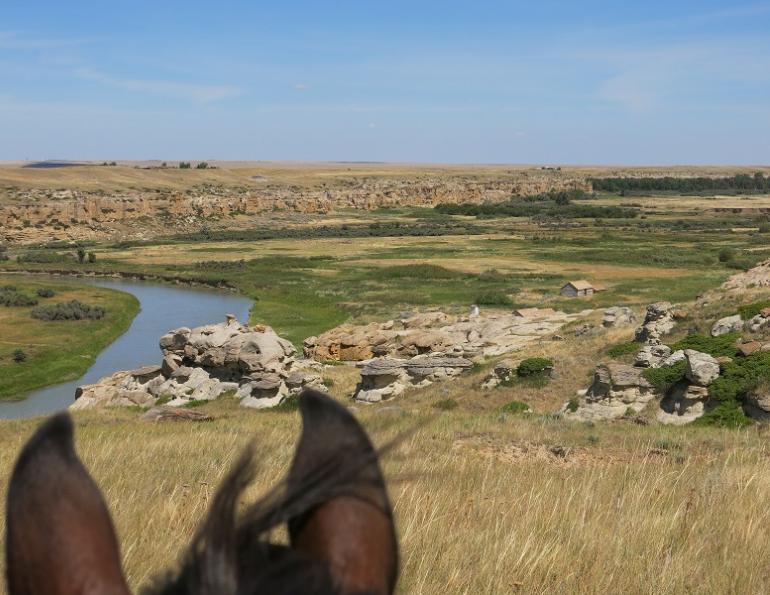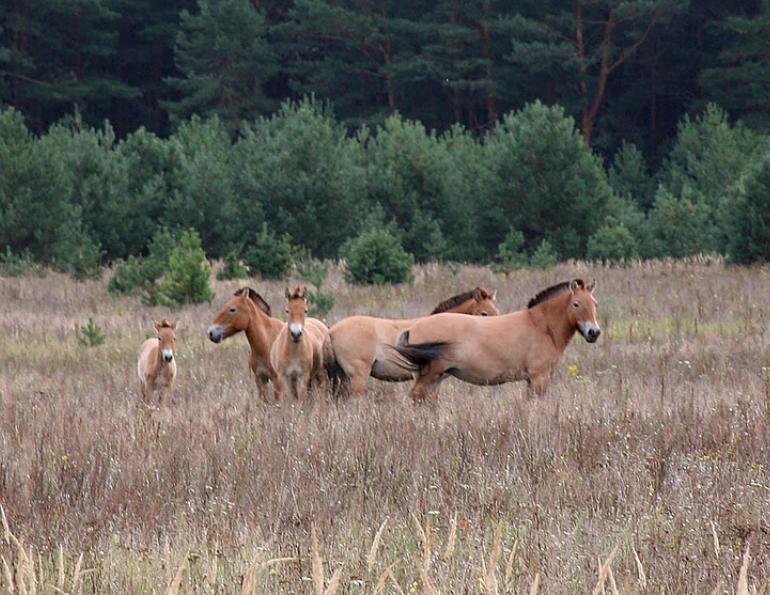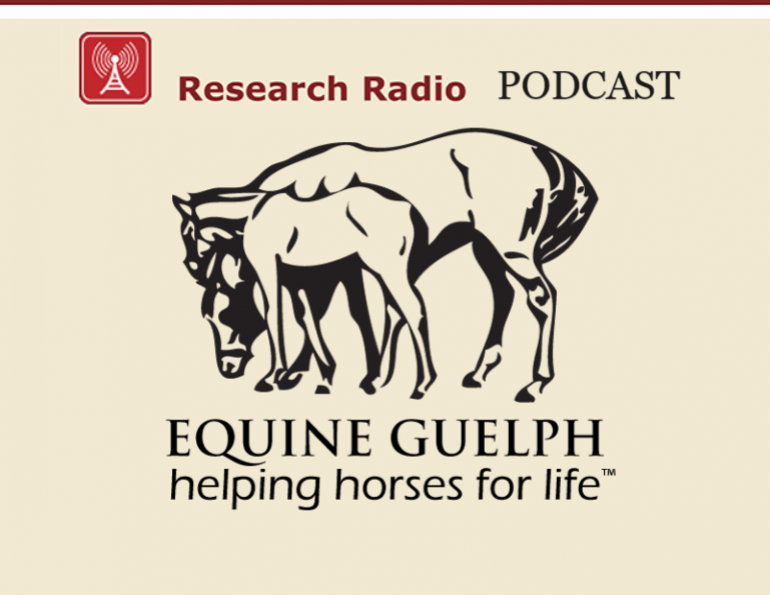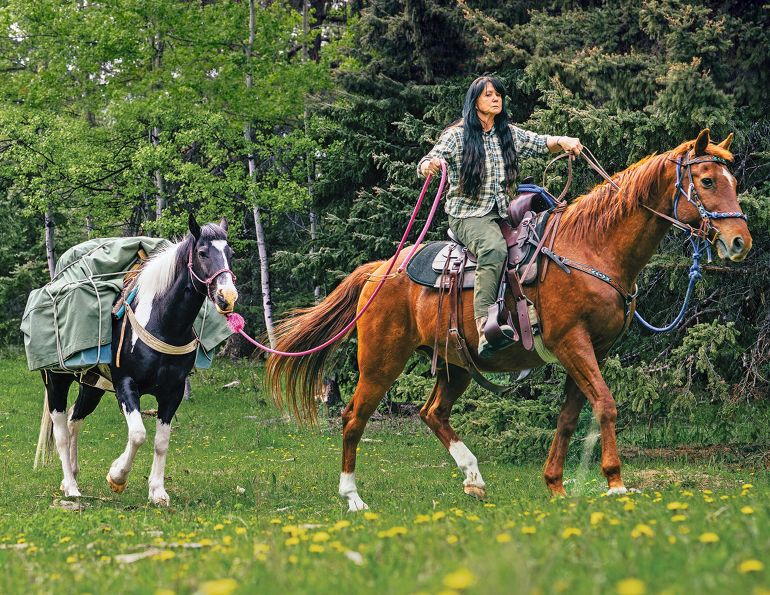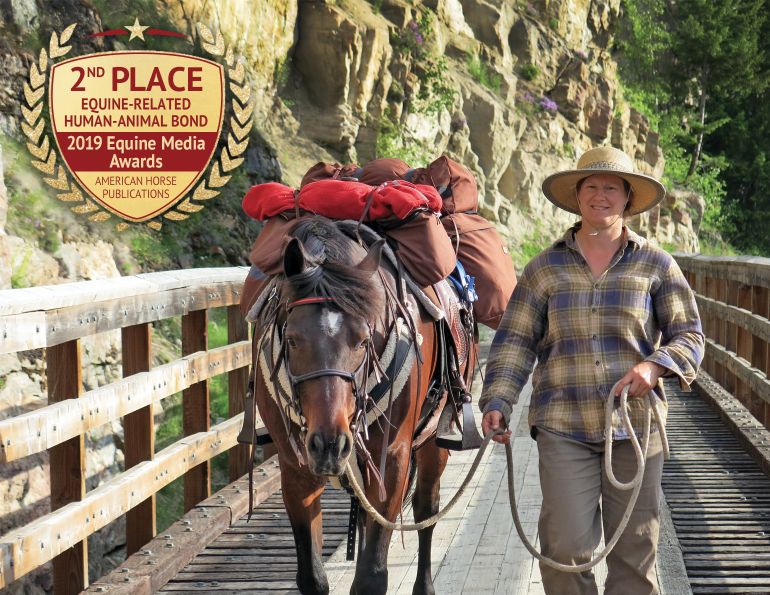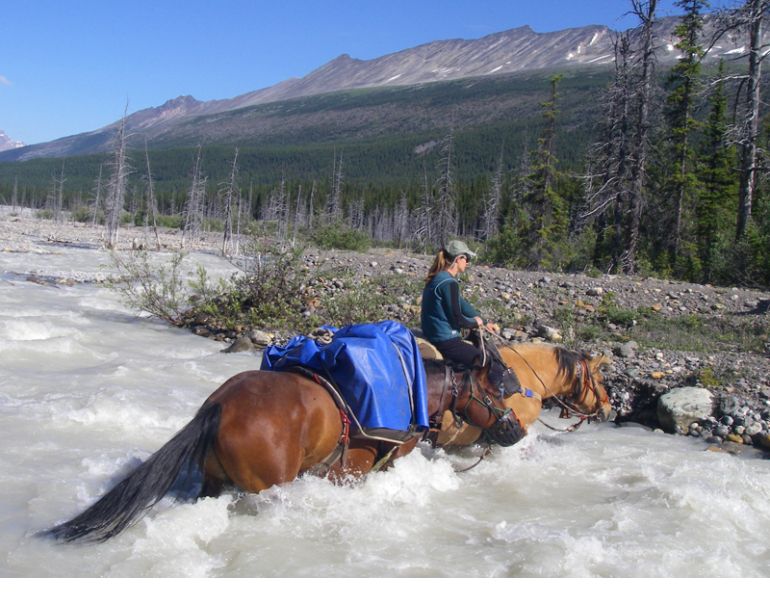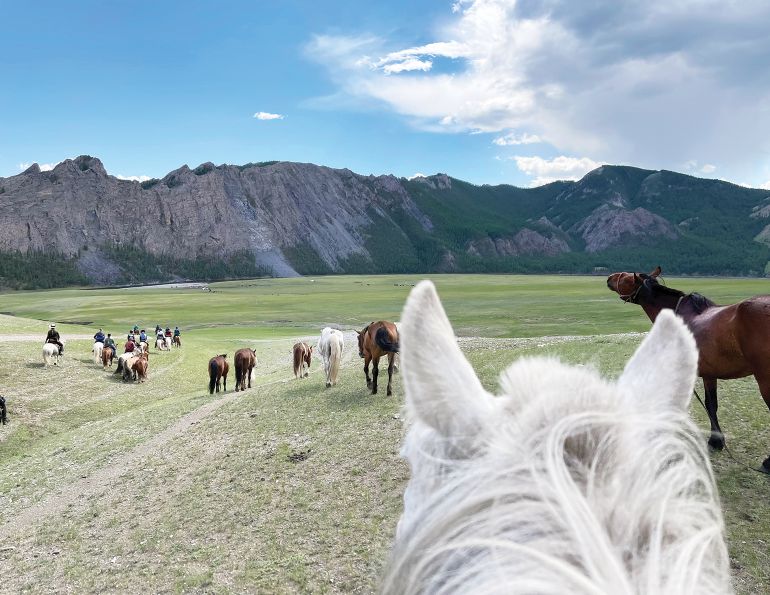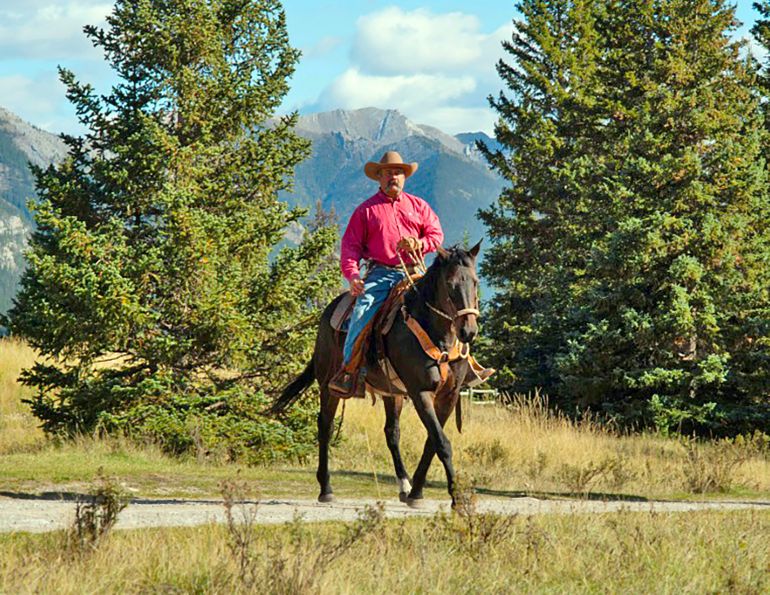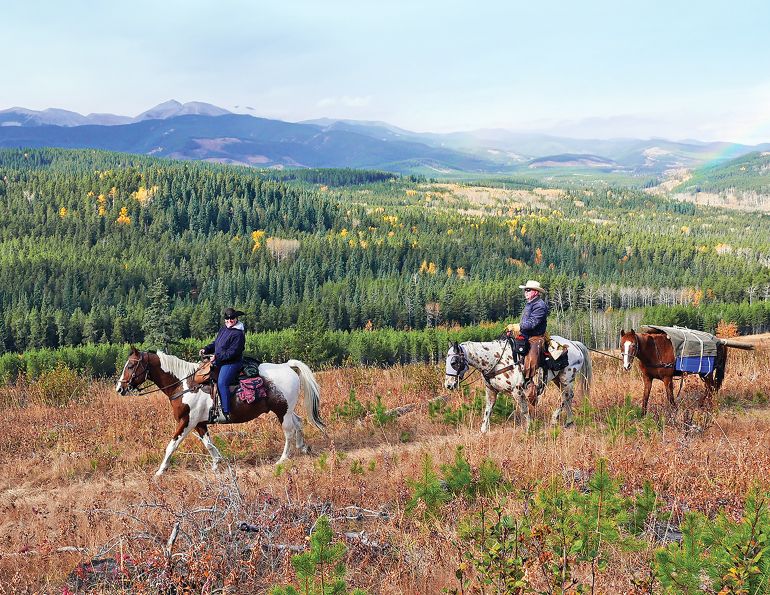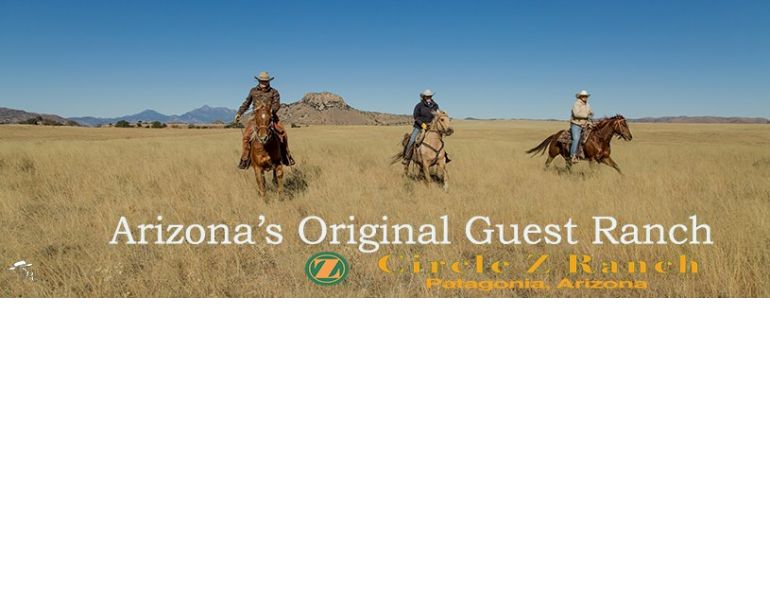Story and photos by Tania Millen, BSc, MJ
“Rattlesnake!”
“Where? Where? Where?”
“Right here in the grass!”
“Over there in the water!”
“Be careful where you step.”
I scanned the tall grass in front of me and the puddle lurking in the dark recesses of our lunch spot.
“Hey, look, there’s one climbing the wall!” I called out.
Our group of 17 horses and riders had taken shelter from the brutal midday sun beneath a massive overhang created thousands of years ago when water roared through the valley, and our chosen lunch spot was also home to several rattlesnakes.
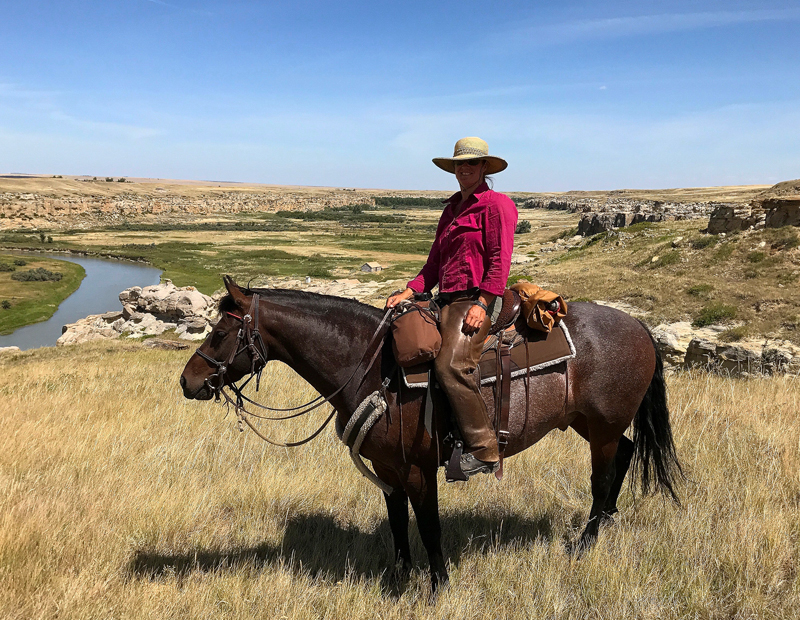
The author, Tania Millen, with her Spanish Mustang gelding, Chocolate, overlooking the Milk River valley.
It was mid-July, and we were riding through Writing-on-Stone Provincial Park in southern Alberta. The park had been on my must-ride list for a long time; however, horseback access to the park is restricted, and riders must be escorted by one of two authorized guides. So when Southern Alberta Trail Riders – a fun group that rides Alberta’s trails - planned a trip, I became a member and tagged along.
Writing-on-Stone Provincial Park and Áísínai‘pi National Historic Site are located along the Milk River near the Alberta-Montana border, and are best known for First Nations rock art. The name Writing-on-Stone is the English name for the site, while Áísínai‘pi means “where the drawings are” in Blackfoot. Visitors come from all over the world to visit, camp, take walking tours, plus learn about the First Nations, North-West Mounted Police, hoodoos, desert-like flora and fauna, and former bison herds. The surrounding grassland prairie is fairly flat, but sandstone formations, cliffs, coulees, and hoodoos along the meandering Milk River create a spectacular landscape.
Related: On a Quest to Ride with Bison in Canada's National Parks

Guide Les O’Hara, who grew up on a homestead on the north side of the Milk River, and spent his childhood riding on what is now the Writing-on-Stone Provincial Park.
The Milk River is the only watershed in Canada that flows into the Mississippi River, which eventually empties into the Gulf of Mexico. The Milk arises in the American Rocky Mountains, then flows north into Canada, through Writing-on-Stone, then turns south again and flows back into the United States. The town of Milk River – the only community situated along the Canadian portion of the river – has the unique motto Under Eight Flags. This is because the town is located in the massive Mississippi River watershed which has been bought, sold, claimed, and conquered by empires with eight different flags: the Hudson’s Bay Company, France, the Spanish Empire, the French Republic, the United States, the British Empire, Canada’s Red Ensign, and the current Canadian Maple Leaf. Prior to these claims, the Blackfoot Nation controlled the area, plus hunting and raiding parties of Cree, Gros Venture, Assiniboine, Crow, Kutenai, and Shoshone passed through.
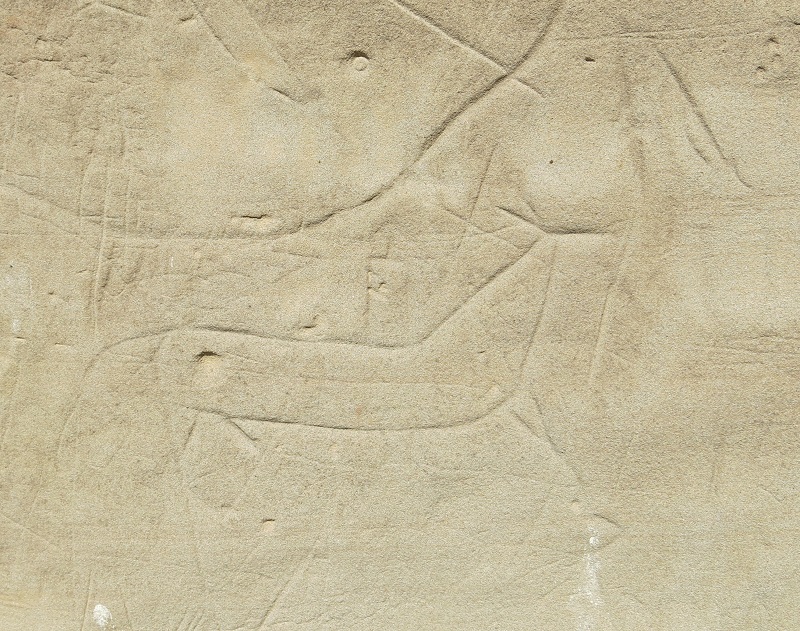
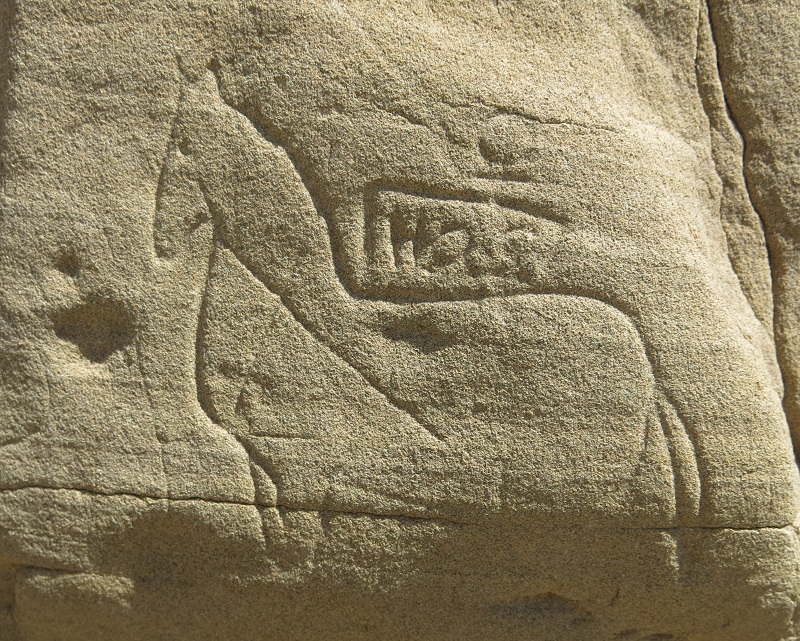
The Writing-on-Stone Provincial Park is home to the largest assemblage of rock art in North America, believed to be up to 5,000 years old. There are over 50 petroglyph sites and thousands of works, among them this indigenous horse petroglyph, and what is possibly a NWMP horse petroglyph.
Our guide to this special place was 70-something Les O’Hara, whose family has lived in these parts since the early 1900s. Les grew up on a homestead on the north side of the river, just west of the current park boundary, and spent his childhood riding what is now park land. In 1957, his father donated land to the province of Alberta so that the current rodeo grounds could be constructed – the same grounds where we would be camping. It was an honour to be guided by such a knowledgeable and fun-loving cowboy, who - at an age when many are hanging up their spurs - still voluntarily shares the land and stories that he knows so well.
On a hot Friday night, 17 horses and riders arrived at the rodeo grounds and settled in for the weekend. High temperatures across western Canada had created extreme fire risk in many places and much of the prairies had banned shod horses, but the park hadn’t instituted a ban yet, so our ride was going ahead. The grounds are located immediately west of the park and have pipe corrals, an arena, and – best of all – a sandy horse-swimming beach. As the sun went down, the air cooled and adjacent cliffs glowed red, creating peace in the valley and providing a glimpse of how extraordinary this place is.
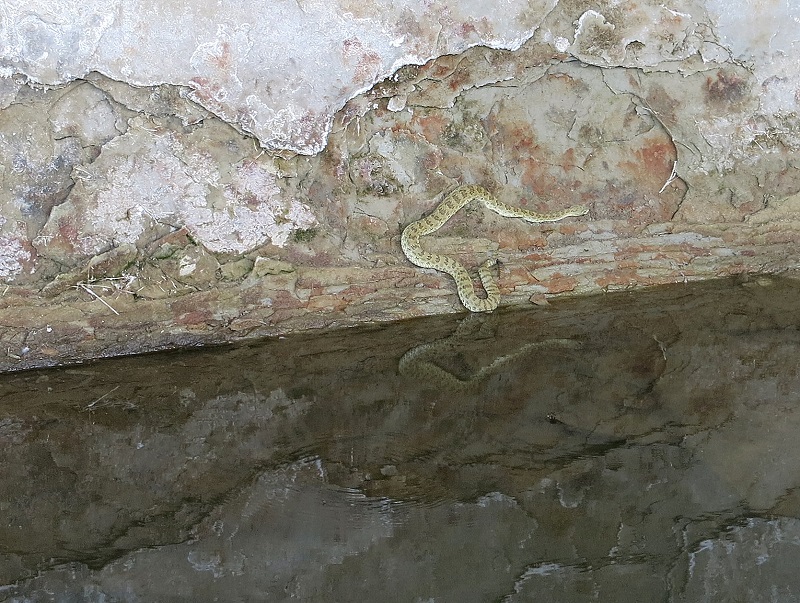
The lunch spot was home to numerous prairie rattlesnakes.

Chocolate resting in the shade beneath the overhang at the midday lunch break.
Day-long rides were planned for Saturday and Sunday, with Les deciding where we’d go based on the group’s desires. Saturday’s ride was up Police Coulee, which is named for the North-West Mounted Police (NWMP) outpost that was built at its mouth, near the banks of the Milk River. The NWMP was formed in 1873, then the Mounties rode west in 1874 to provide stability to the prairie region and stop the illegal cross-boundary liquor trade whose powerful product was devastating the First Nations. They camped at Writing-on-Stone briefly in 1874, but it wasn’t until 1887 that a summer tent camp was established, followed by construction of an outpost in 1889.
Nearly 70 metres deep in places, Police Coulee extends south beyond the US border - just nine kilometres from the Milk River - and was a popular north-south route for whiskey smugglers. It is a significant feature of the park, hosting rock art, archaeological sites, historical sites, uncommon frogs, butterflies and songbirds, plus rattlesnakes, cougar, coyote, and deer. But Police Coulee is seldom visited as it’s located on the opposite side of the Milk River from the Park Visitor Centre, campsite and public road access, plus park regulations require visitors to be guided. Fortunately for us, we had horses that could cross the river, and Les to guide us.
Related: Solo Packing Adventures in Canada's Southern Rocky Mountains
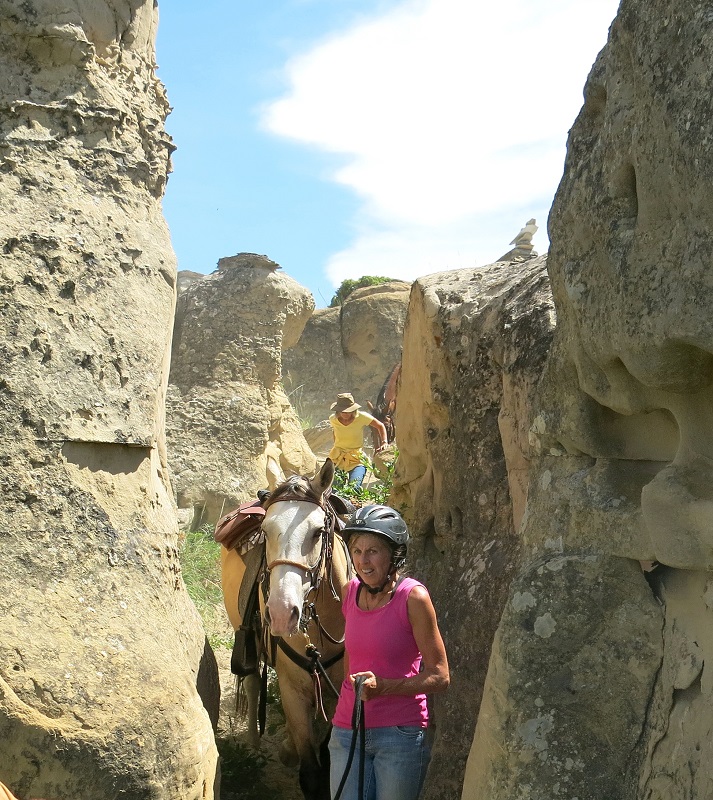
Leading through the sculpted rock hoodoos.
Not knowing the riders, I was concerned about riding with such a large group of horses, and how my Spanish Mustang, Chocolate, would behave. But my fears were alleviated on Saturday morning when many riders – including me - did groundwork with their horses before they climbed on. Apparently the club had hosted several horsemanship clinics throughout the winter and it really showed. The riders were prepared and horses well behaved. Chocolate fit right in.
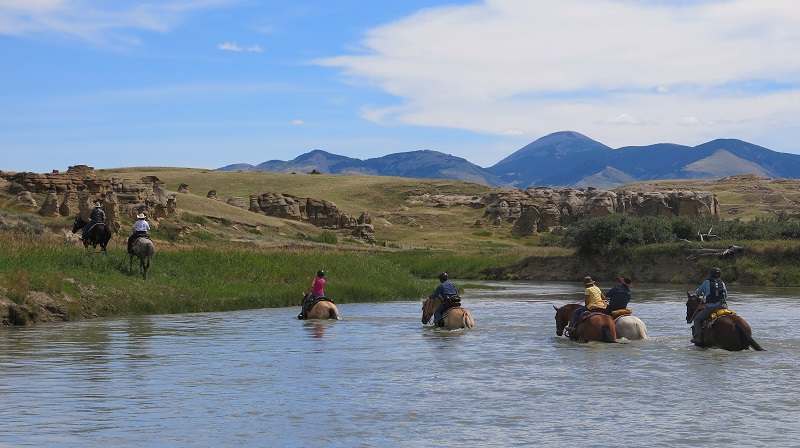
The cool water of the milk river was a refreshing respite from the mid-day heat.
Our ride took us south across the Milk River, which is named for its colour and the clay and silt that it carries, then past the reconstructed NWMP outpost and into Police Coulee itself. Compared to the surrounding prairie, the coulee was lush with tall native grasses, brush, a swampy creek, mud, and even a cottonwood tree, which Les is convinced remains healthy due to discharge from an illegal one-man whiskey distillery many moons ago.
It was almost 30 degrees Celsius when we started riding, but in the depths of the coulee it was even hotter. We meandered upstream criss-crossing the swampy creek, watching for wildlife and being astounded by ever-changing canyon views. It was surprising how much cooler it was in the shade near the cliff walls, and we flushed many deer resting in the shadows. I was riding near the back of the pack when riders up ahead whispered “Cougar!” and over the next kilometre, there was lots of pointing and discussions about whether the creature was actually a cougar. Eventually, a healthy-looking coyote loped up through the stepped cliffs to the prairie above us, making a brutal and tricky climb look effortless.
By midday, the temperature was in the high thirties, and we stopped beneath a massive overhang for lunch, inadvertently flushing out rattlesnakes. Earlier in the summer I’d ridden through southern BC’s rattlesnake country, but hadn’t actually seen the elusive critter, so I was excited to see live ones – from a safe distance. Prairie rattlesnakes immobilize their rodent, bird, and reptile prey with a bite from their venom-filled fangs, before swallowing them whole. However, rattlesnake bites are rarely fatal to humans and they seldom strike at large moving objects unless threatened, stepped on, or cornered. They were a much greater concern for the horses than for the riders.
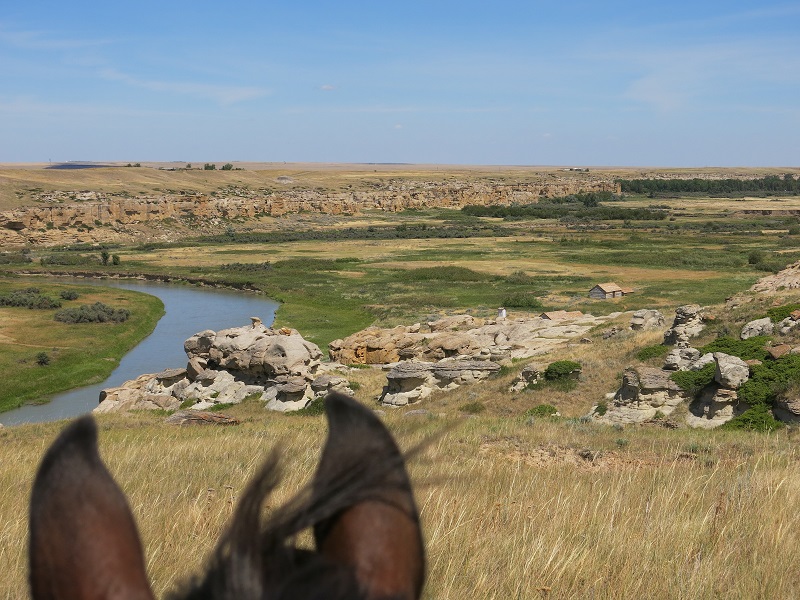
A view of the Milk River, with the North-West Mounted Police outpost buildings on the right. Originally constructed in 1889, the outpost was closed in 1918 and soon after fell victim to arson. The park was created in 1957, and outpost was reconstructed between 1973 and 1975 as part of the NWMP centennial celebrations and is now one of the attractions in the park.
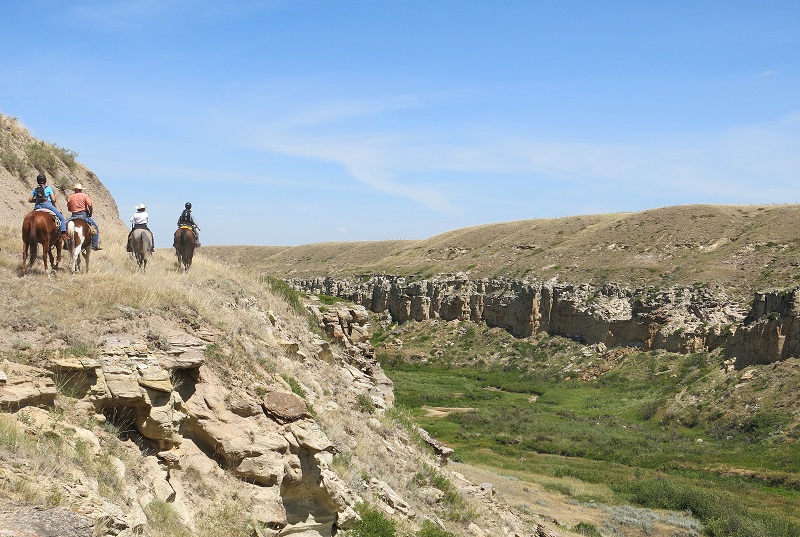

The spectacular view of Police Coulee with Montana’s Sweet Grass Hills beyond.
The horses were happy to cool off crossing the river, before returning to the rodeo grounds hot and tired in late afternoon temperatures near 40 degrees Celsius. Horse swimming plus a potluck dinner followed, along with some tall tales.
The following day I made the tough choice to forgo riding and give Chocolate a well-earned rest, instead choosing to hike through the hoodoos, check out the impressive park visitor centre, and take a guided tour of the rock art.
The park contains the largest concentration of rock art in North America, with both pictographs (painted works) and petroglyphs (incised art), present. It depicts human figures in various forms, animal figures, and material items such as shields, bows, spears, and guns. Some art works may be 5,000 years old. Much of the art is considered ceremonial and perhaps used to predict the future, while some First Nations people believe the art is the work of spirits. The art’s meaning may never be known, but there’s no doubt it’s an irreplaceable legacy, set in a place that First Nations understandably consider sacred.
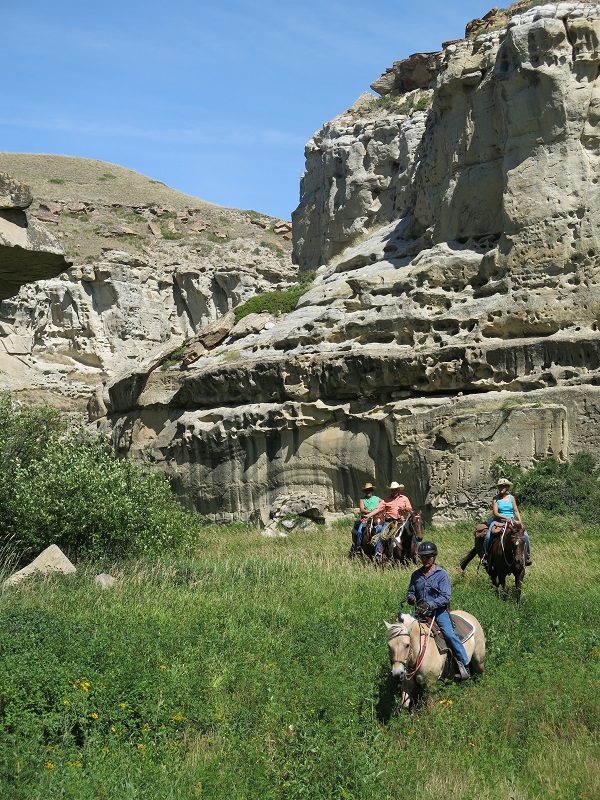

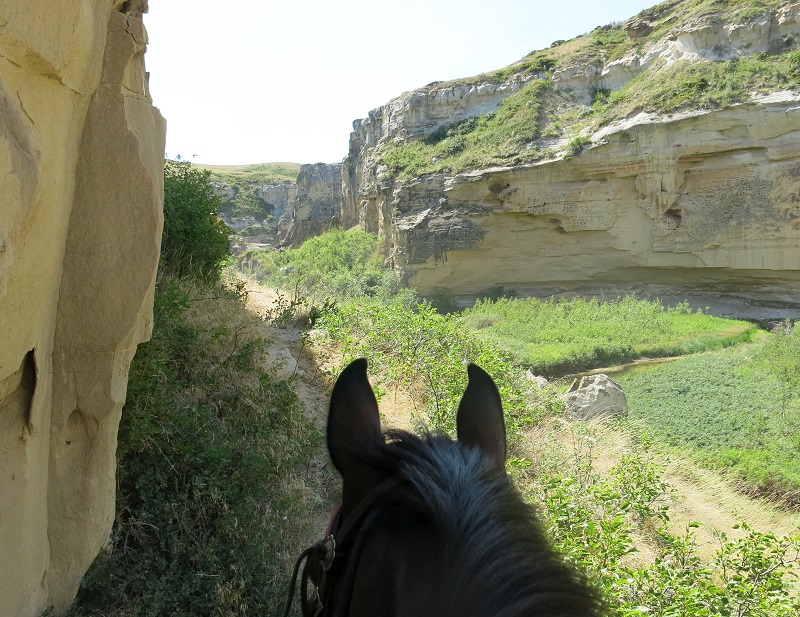
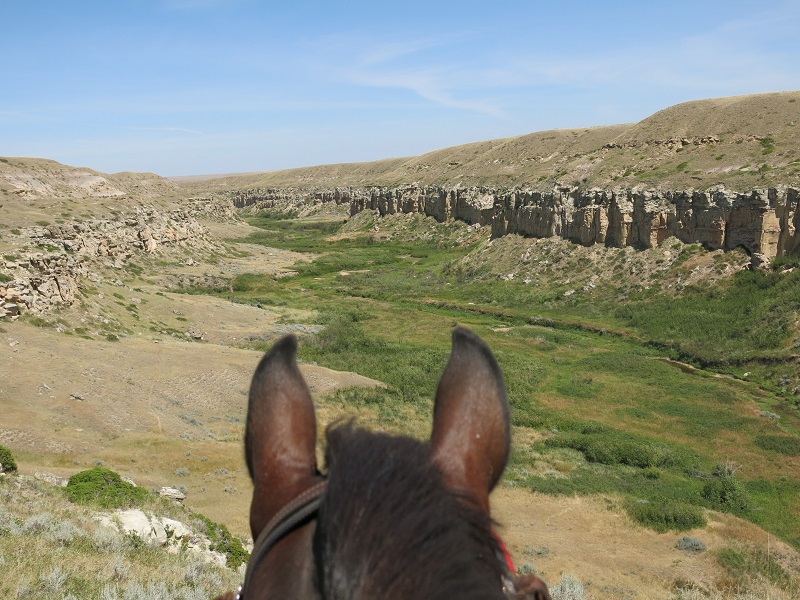
Views of Police Coulee, which is nearly 70 metres deep in places, and was formerly a popular north-south route for whiskey smugglers.
Although it was history and geography that drew me to Writing-on-Stone, it was the feel of the place – peaceful, grand and other-worldly, with an unrelenting climate and impervious landscape – that I found both enthralling and slightly intimidating. Visiting the area by horse provided a unique perspective too, and after hearing about the spectacular Sunday ride I missed, and having experienced the spell of the place, I’ll undoubtedly return.
I hope you get to visit this special place, too.



